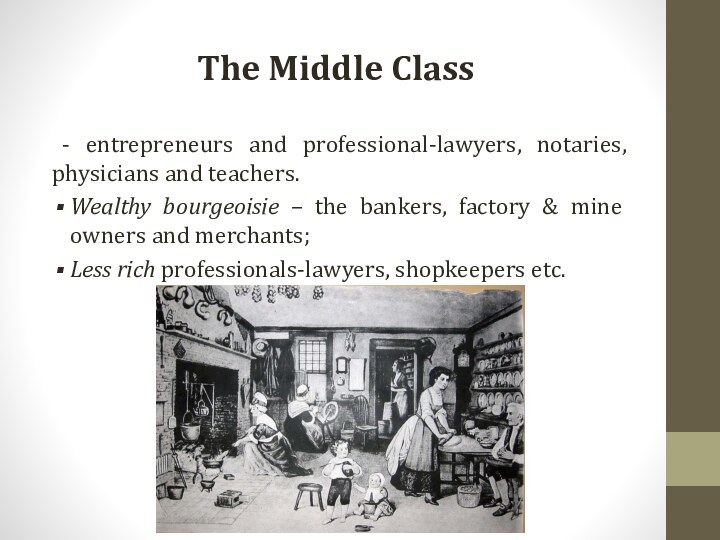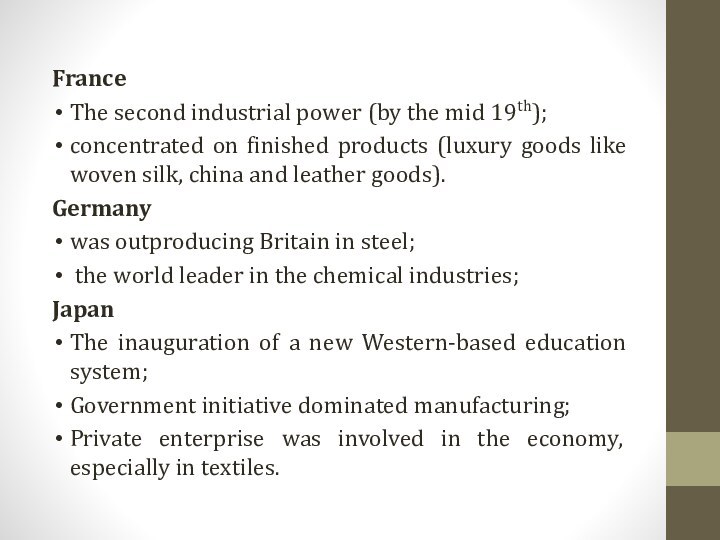Слайд 2
The Stages of IR
The First Industrial Revolution (1770-s
-1850/70-s )
- on steam, water, iron and shift from
agriculture;
The Second Industrial Revolution (1870-s to 1914)
- new technologies of electricity, development of petrol engine, oil, and greater use of cheap steel.
Слайд 3
The reasons for IR
Growth in global trade;
Agricultural revolution;
new
techniques (crop rotation, selective breeding, etc.);
new crops (corn
and potatoes);
Enclosure Movement in Britain;
Слайд 4
Agricultural Inventions
Jethro Tull's Seed drill
Bakewell’s quick-fattening sheep for
mutton
Слайд 5
The reasons for IR
Increased speed of transportation;
Слайд 6
The reasons for IR
Application of steam engines.
Слайд 7
Why in Britain?
Increased Food Production;
Population Growth;
Financial Innovations:
central
banks, stock markets, joint stock companies
The Enlightenment and the
Scientific Revolution
Слайд 8
Why in Britain?
Coal and Iron deposits;
Navigable Rivers and
Canals;
Government Policies;
World Trade
The Cottage Industry
Слайд 9
Social Changes
New family and class structures emerged;
New
classes: the working class and the middle class (bourgeoisie)
Population migration from rural areas to urban areas.
Слайд 10
Working Class
Introduced mechanisms of labour supervision;
schools set
up in collaboration with the church to inculcate values;
the
specialization of work;
Слайд 11
The Middle Class
- entrepreneurs and professional-lawyers, notaries,
physicians and teachers.
Wealthy bourgeoisie – the bankers, factory &
mine owners and merchants;
Less rich professionals-lawyers, shopkeepers etc.
Слайд 12
The Family
The 18th century family (pre-industrial):
(a) kin members
like widows, siblings, step children
(b) non-kin members like
servants, tutors etc.
All family members engaged in domestic production (family economy).
In the 19th century - ‘family wage economy’
only kin members living under one roof;
the private sphere - handled by wives/mothers;
the public sphere of work, commerce and politics -men.
Слайд 13
The Working Class Family
women contributed wages to the
family fund, managed the house, bore and cared for
children;
married women were not working - the concept of a ‘male bread winner’ emerged;
children and specially daughters were an important economic recourse
Слайд 14
The Middle Class Family
Children and wives usually didn't
work;
The mother’s role as chief organizer of the house
was valued;
private bedrooms became distanced from common spaces like the kitchen and parlour;
family activities (playing the piano after dinner) and family holidays developed.
Слайд 15
Inventions
The spinning jenny, invented in 1764 by James
Hargreaves, is a multi-spindle spinning frame, was one of
the key developments in the industrialization of weaving.
Слайд 16
Edmund Cartwright’s power loom (1787) enabled mass production
of cloth.
Слайд 17
Steam engine (developed by James Watt in the
1760s) further transformed the cotton industry and later steam
trains.
Слайд 18
Smelting iron, pig iron. A new method of
producing iron, developed by Abraham Darby (1678-1717).
Слайд 19
Steam train. Richard Trevithick invented the first working
steam train 1806.
Слайд 20
Other countries
Belgium
The IR was brought by William and
John Cockerill by developing machine shops at Liège;
centred in
iron, coal, and textiles.
Switzerland
the lack of raw materials was compensated specialising in niche products (silk weaving, cotton processing and engineering, clock-making)
Слайд 21
France
The second industrial power (by the mid
19th);
concentrated on finished products (luxury goods like woven silk,
china and leather goods).
Germany
was outproducing Britain in steel;
the world leader in the chemical industries;
Japan
The inauguration of a new Western-based education system;
Government initiative dominated manufacturing;
Private enterprise was involved in the economy, especially in textiles.
Слайд 22
In the USA occurred the Second Industrial Revolution.
(mid-18th).
After the Civil War;
built on the advancements made in
Britain;
the build out of railroads;
large-scale iron and steel production;
widespread use of machinery in manufacturing;
use of the telegraph;
use of petroleum.
Слайд 23
Problems of the IR
Great pollution
The West Midlands became
known as the ‘Black Country’.
Слайд 24
Lower worker class lifespan;
Child labour;
poor sanitation;
The slave trade
Слайд 25
Benefits of the IR
Higher real wages;
Life expectancy rose;
First
government regulations;
Education and health care;
Movement of people;
Wealth led to
philanthropy.
Слайд 26
Bibliographical References
Industrial Revolution [Электронный ресурс] / New Word
Encyclopedia. – Режим доступа: http://www.newworldencyclopedia.org/entry/Industrial_Revolution#History_of_the_name, свободный.
Industrial Revolution [Электронный ресурс]
/www.referatele.com. – Режим доступа: http://www.referatele.com/referate/engleza/online21/Industrial-Revolution---Reasons-why-the-Industrial-Revolution-began-Agrarian-Revolution-Social-condi.php, свободный.
Facts about the Industrial Revolution [Электронный ресурс] / Biography Online. – Режим доступа: https://www.biographyonline.net/facts-about-the-industrial-revolution/, свободный.
Слайд 27
The Industrial Revolution [Электронный ресурс] / myglobal2009.wikispaces.com. –
Режим доступа: https://docviewer.yandex.ru/view/156256976/?*, свободный.
The Industrial Revolution Begins in England
(1760-1850) [Электронный ресурс] /Modern World History. – Режим доступа: http://webs.bcp.org/sites/vcleary/modernworldhistorytextbook/industrialrevolution/IRbegins.html, свободный.
Collingwood R.G. Social impact of industrial revolution // Idea of History [Электронный ресурс] / R. G. Collingwood. – Режим доступа: http://idea-of-history.blogspot.ru/2012/12/social-impact-of-industrial-revolution.html, свободный.
The Industrial Revolution in Europe [Электронный ресурс] / European Route of Industrial Heritage. – Режим доступа: http://www.erih.net/how-it-started/the-industrial-revolution-in-europe/, свободный.
Слайд 28
Industrial Revolution [Электронный ресурс] / Encyclopedia Britannica. –
Режим доступа: https://www.britannica.com/event/Industrial-Revolution, свободный.
The Industrial Revolution in Europe, Russia,
and Japan [Электронный ресурс] / Prezi. – Режим доступа: https://prezi.com/nohdiij0rdiu/the-industrial-revolution-in-europe-russia-and-japan/, свободный.
Industrialization of Japan [Электронный ресурс] / Weatern Civilization II Guides. – Режим доступа: http://westerncivguides.umwblogs.org/2012/05/03/industrialization-of-japan/, свободный.
Child Labor during the British Industrial Revolution [Электронный ресурс] /EH.net. – Режим доступа: http://eh.net/encyclopedia/child-labor-during-the-british-industrial-revolution/, свободный.

























![The Industrial Revolution and Its Influence on the Country Bibliographical ReferencesIndustrial Revolution [Электронный ресурс] / New Word Encyclopedia. – Режим доступа:](/img/tmb/14/1399519/dca34e995f6f6efc36afb8e0a554dde4-720x.jpg)
![The Industrial Revolution and Its Influence on the Country The Industrial Revolution [Электронный ресурс] / myglobal2009.wikispaces.com. – Режим доступа: https://docviewer.yandex.ru/view/156256976/?*, свободный.The](/img/tmb/14/1399519/fc323e35579f398591a6d62cca315583-720x.jpg)
![The Industrial Revolution and Its Influence on the Country Industrial Revolution [Электронный ресурс] / Encyclopedia Britannica. – Режим доступа: https://www.britannica.com/event/Industrial-Revolution, свободный.The](/img/tmb/14/1399519/ce106c2aa01b66e7a98e712035b50a12-720x.jpg)






























